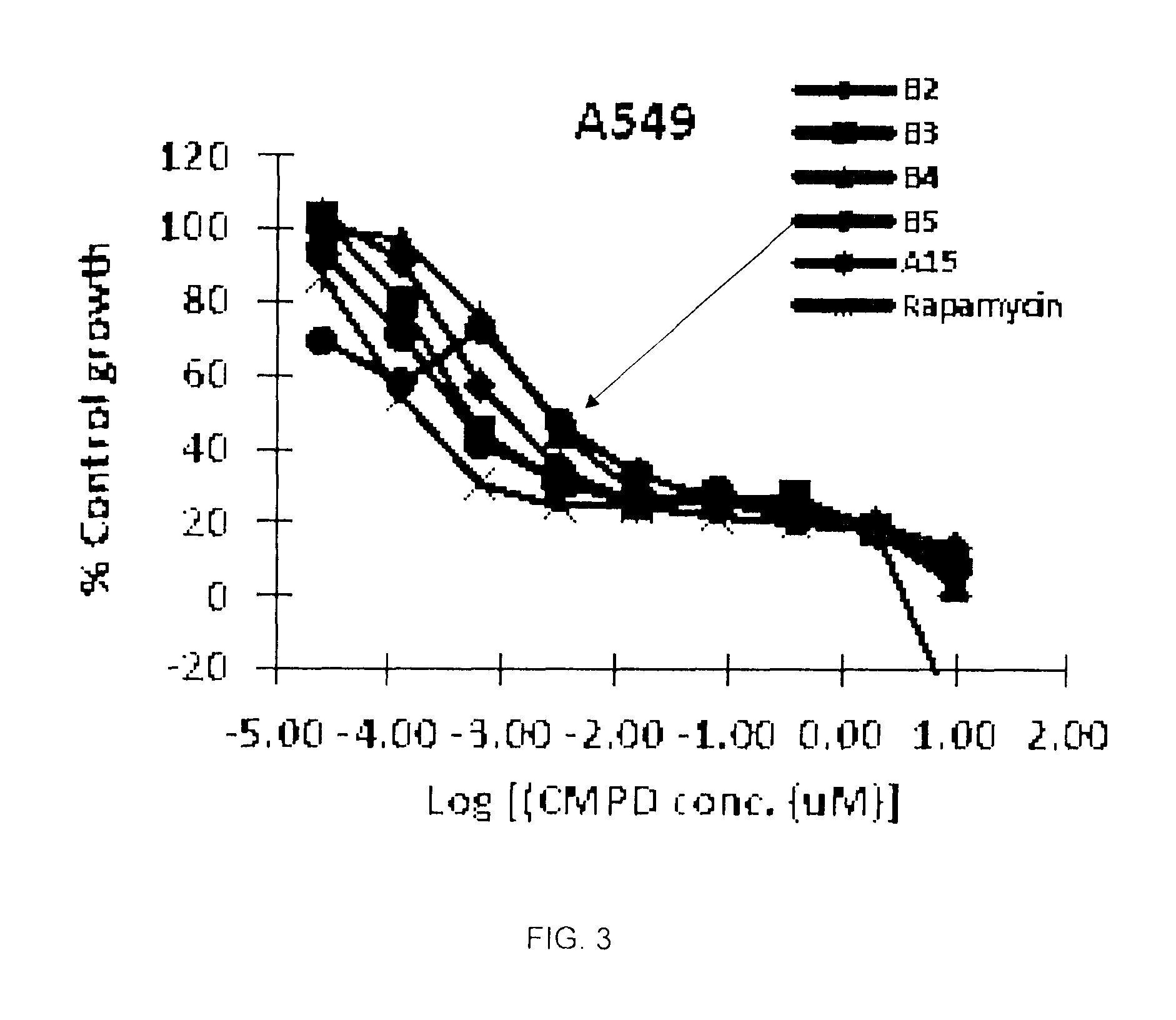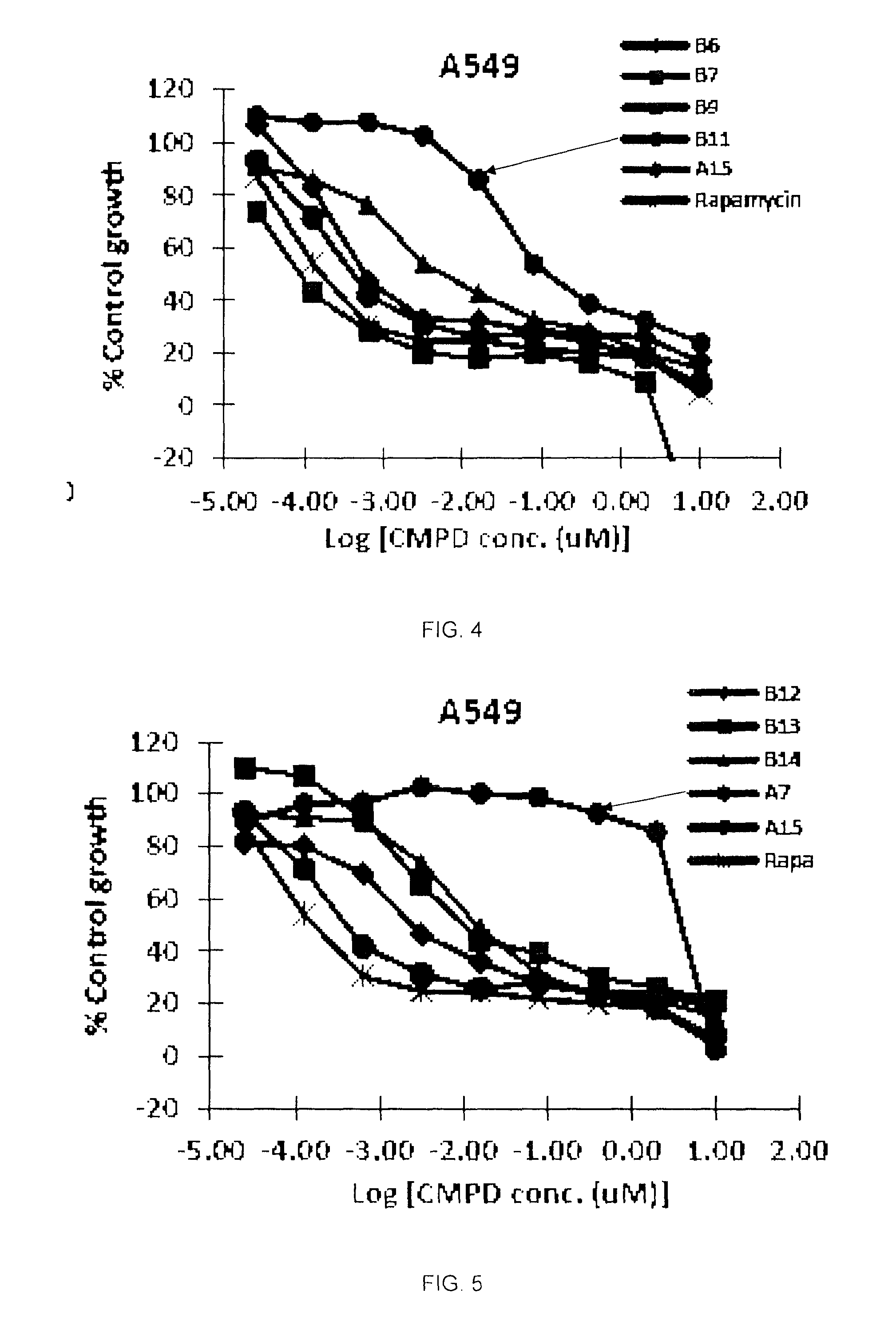Rafamycin analogs and methods for making same
a technology of rafamycin and analogs, applied in the field of rafamycin analogs and methods for making same, can solve problems such as ineffective systemically
- Summary
- Abstract
- Description
- Claims
- Application Information
AI Technical Summary
Benefits of technology
Problems solved by technology
Method used
Image
Examples
example 1
of Compound A1
[0058]To a stirred solution of Rapamycin (3 g, 3.2 mmol) and Cs2CO3 (3.2 g, 9.6 mmol) in dried PMF (90 mL) was added Nal (1.5 g, 9.6 mmol) and 3-bromoprop-1-yne (1.2 g, 9.6 mmol). The reaction mixture was stirred at rt for 30 hours. Upon the completion of reaction, 300 mL water was added in and extracted with ethyl acetate (200 mL×3). The combined organic layer was washed by brine (300 mL) and dried over anhydrous Na2SO4. After concentration, the residue was purified with silica gel chromatography (50% to 100% of ethyl acetate in petroleum ether as eluent) to give the compound A1 (2.1 g, 68%) as a light green oil.
LCM (m / z) ES-950 (M−1)−.
example 2
of Compound A3
[0059]To a solution of 40-O-(prop-2-ynylox) rapamycin A1 (200 mg, 0.2 mmol) and 1-azido-Admantane (100 mg, 0.6 mmol) in anhydrous THF (9 mL) was added DIPEA (100 μL, 0.6 mmol) and CuI (20 mg, 0.1 mmol) under N2. The solution was stirred at rt overnight. Then, 20 mL water was added and extracted with ethyl acetate (20 mL×3). The combined organic layer was washed by brine and dried over anlndrous Na2SO4. After concentration, the residue was purified with silica gel chromatography (25% to 50% of ethyl acetate in petroleum ether as eluet) to give white solid which was further purified by prep-HPLC to give Compound A3 (26 mg, 10%) as a white solid. 1H NMR (300 MHz, CDCl3) δ7.71 (s, 1H), 6.74 (m, 1H), 6.39-6.02 (m, 5H), 5.62-5.36 (m, 5H): LCMS (m / z) ES-1128 (M−1)−.
example 3
of Compound A4
[0060]To a solution of 40-O-(prop-2-ynyloxy) rapamycin A1 (200 mg, 0.2 mmol) and 4-azidobenzoic acid (100 mg, 0.6 mmol) in anhydrous THF (9 mL) was added DIPEA (100 μL, 0.6 mmol) and CuI (20 mg, 0.1 mmol) under N2. The solution was stirred at rt for 3 hours. Then, 20 mL water was added and extracted with ethyl acetate (20 mL×3). The combined organic layer was washed by brine and dried over anhydrous Na2SO4. After concentration, the residue was purified with silica gel chromatography (5% to 10% of methanol in dichloromethane as eluent) to give white solid which was further purified by PREP-HPLC to give Compound A4 (29 mg, 12%) as a white solid. 1H NMR (300 MHz, CDCl3) δ8.27 (m, 1H), 7.90 (m, 1H), 7.73 (m, 1H), 7.56 (m, 1H), 6.74 (m, 1H), 6.55-6.00 (m, 5H), 5.60-5.36 (m, 5H); ECMS (m / z) ES-1114(M−1)−.
PUM
| Property | Measurement | Unit |
|---|---|---|
| volume | aaaaa | aaaaa |
| volume | aaaaa | aaaaa |
| volume | aaaaa | aaaaa |
Abstract
Description
Claims
Application Information
 Login to View More
Login to View More - R&D
- Intellectual Property
- Life Sciences
- Materials
- Tech Scout
- Unparalleled Data Quality
- Higher Quality Content
- 60% Fewer Hallucinations
Browse by: Latest US Patents, China's latest patents, Technical Efficacy Thesaurus, Application Domain, Technology Topic, Popular Technical Reports.
© 2025 PatSnap. All rights reserved.Legal|Privacy policy|Modern Slavery Act Transparency Statement|Sitemap|About US| Contact US: help@patsnap.com



